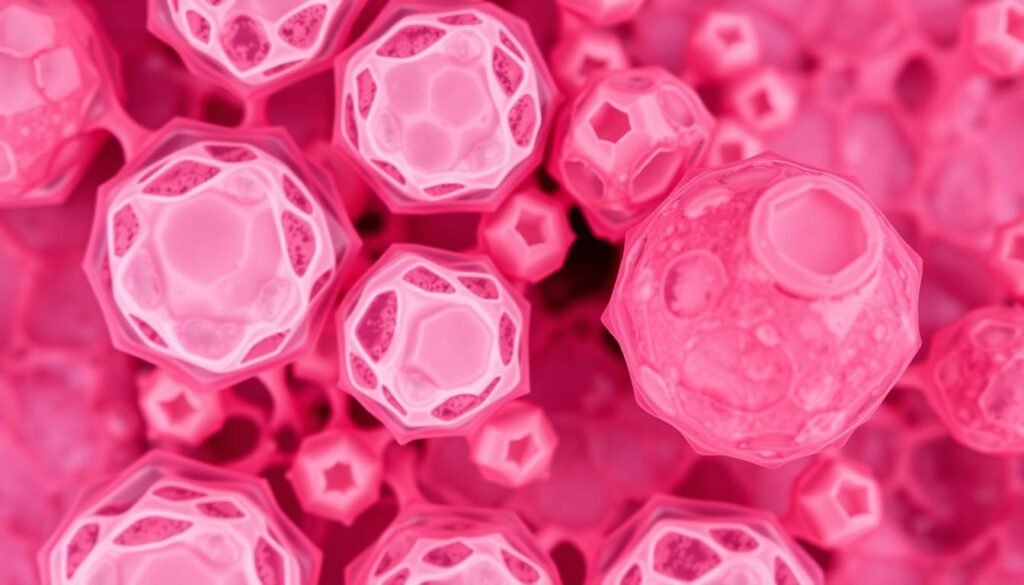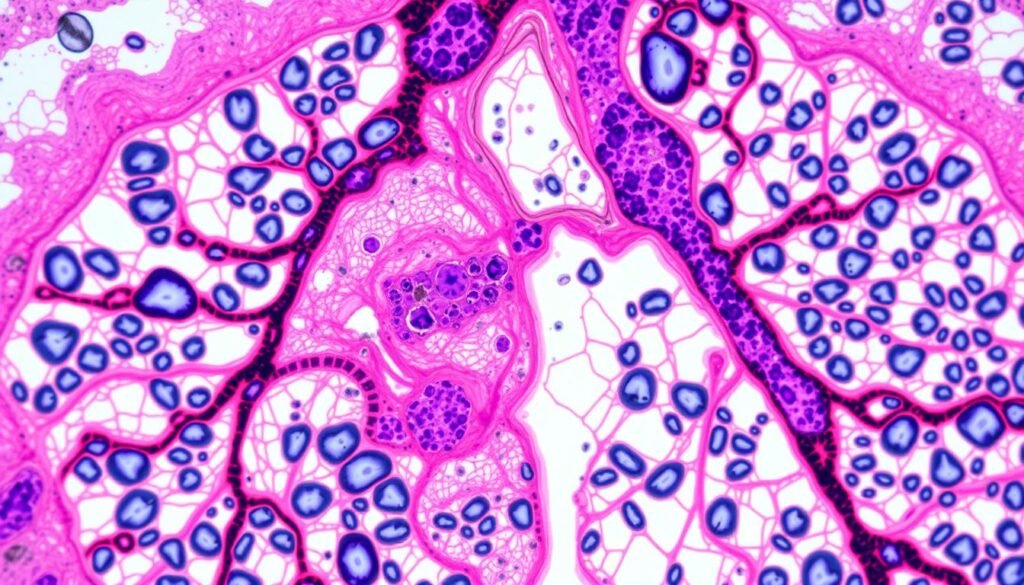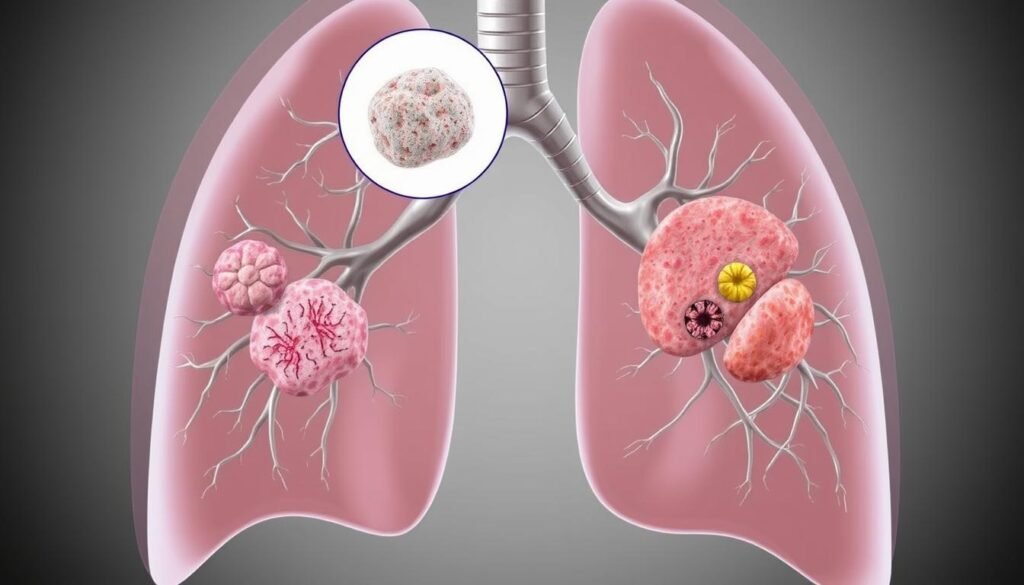About 80% to 85% of lung cancers are known as non-small cell lung cancer (NSCLC). This fact shows how common various lung cancer types are. It also shows why knowing the differences is key for the right treatment. Lung cancer affects the breathing system seriously, so we need to correctly identify the cancer type for proper treatment.
It’s important to know the differences between lung cancer types. Non-small cell lung cancer is the most common kind, while small cell lung cancer (SCLC) is less common. Understanding these categories helps people make better health decisions. Early signs like a constant cough or losing weight without trying are critical to catch early for a better chance at fighting the disease. For more details on signs to watch for, see this guide on early symptoms of lung.
Key Takeaways
- Non-small cell lung cancer (NSCLC) is responsible for 80% to 85% of lung cancer cases.
- Small cell lung cancer (SCLC) accounts for about 10% to 15% of cases, often diagnosed at advanced stages.
- Adenocarcinoma is the most common subtype of NSCLC, frequently found in both smokers and nonsmokers.
- Understanding distinct lung cancer subtypes aids in better diagnosis and treatment approaches.
- Early detection of symptoms can significantly improve treatment outcomes and survival rates.
Introduction to Lung Cancer
Lung cancer starts in the lungs, which are key for breathing. It’s hard to catch early because its symptoms of lung cancer are not obvious. These can be a constant cough, pain in the chest, and losing weight without trying. Knowing these signs early can help catch the disease sooner, which helps treatment work better.
There are two main lung cancer types: small cell (SCLC) and non-small cell lung cancer (NSCLC). NSCLC makes up about 80% to 85% of all lung cancers. It includes kinds like adenocarcinoma, squamous cell carcinoma, and large cell carcinoma. Each kind is different, so the treatment needs to be specific.
Getting to know this lung cancer overview helps in understanding the disease. It shows why it’s important to treat each case based on what makes it unique.
What Are Lung Cancer Subtypes?
Lung cancer subtypes fall into main categories: non-small cell lung cancer (NSCLC) and small cell lung cancer (SCLC). They come from different cells in the lungs. These differences affect how they grow, respond to treatments, and what the outcome might be. It’s vital to know the histological subtypes of lung cancer for the best treatment plans.
About 80 percent of lung cancer cases are NSCLC. This group has several key subtypes:
- Adenocarcinoma: The most common NSCLC type, accounting for 40 percent of cases. It begins in the outer parts of the lung.
- Squamous Cell Carcinoma: Makes up about 30 percent of NSCLC cases. It starts near the bronchus, in the lung’s center.
- Large Cell Carcinoma: Known for its fast growth and spreading. It makes up 10 to 15 percent of NSCLC cases.
SCLC, on the other hand, makes up less than 20 percent of lung cancer cases. It’s closely tied to smoking cigarettes. This shows a strong link to this hazardous habit.
Another subtype to know about is lung carcinoid tumors. They only make up 1 to 2 percent of cases. These grow slower than others. Their unique features are often emphasized in lung cancer classification overviews.
Types of Lung Cancer: An Overview
Lung cancer is divided into two main types: non-small cell lung cancer (NSCLC) and small cell lung cancer (SCLC). Knowing the type is key for finding the right treatment and predicting outcomes.
Non-small cell lung cancer makes up about 80 to 85% of lung cancer cases. It’s the most common form. NSCLC has three main types: adenocarcinoma, squamous cell carcinoma, and large cell carcinoma. Each type affects the body differently and needs its own treatment plan. For example, adenocarcinoma is about 40% of lung cancer cases and often occurs in non-smokers.
Small cell lung cancer accounts for 10% to 15% of lung cancer cases. It grows quickly and spreads fast. This type of lung cancer is closely tied to smoking. It is usually found at an advanced stage. For early-stage SCLC, treatment may include chemotherapy and radiation. But when it’s at an extensive stage, it may have spread to both lungs or more. Then, the focus may be on improving life quality rather than curing the disease.
It’s important to stage lung cancer to plan the treatment. Stage 1 NSCLC means the tumor is up to 5 cm and hasn’t spread to the lymph nodes. So, it may be removed surgically. Stage 4 is where cancer has spread to other organs, like the liver or brain. Tools like CT and PET scans help doctors stage the cancer correctly. They use this information to plan the treatment. Find more about this in a lung cancer subtype overview.
Understanding Non-Small Cell Lung Cancer (NSCLC)
Non-small cell lung cancer (NSCLC) is the most seen type, making up 80% to 85% of cases. It usually grows slower than small cell lung cancer (SCLC). Treatment might include surgery, chemotherapy, radiation, or targeted methods, tailored to each situation.
Adenocarcinoma, a kind of NSCLC, is often found in those who don’t smoke. Squamous cell carcinoma is more common in people who have smoked. Large cell carcinoma is known for its quick growth and spread, making early discovery key.
The outlook for NSCLC patients depends on the subtype and how early it’s found. Survival rates at five years for NSCLC are around 26%, higher than SCLC’s 7%. This shows why finding it early and accurately is crucial.
Symptoms of NSCLC can be tiredness, constant cough, feeling short of breath, chest pain, and weight loss without trying. Sometimes, people may not show symptoms, discovering their cancer through tests like CT scans or X-rays unexpectedly.
It’s key for those with NSCLC to work with a team of health experts to figure out the best treatment. For advice, one can look at resources like this source for help in managing their health.

The Main Subtypes of NSCLC
Non-Small Cell Lung Cancer (NSCLC) includes about 80% to 85% of lung cancer cases. It’s crucial to know the main subtypes for treating them right. These subtypes are adenocarcinoma, squamous cell carcinoma, and large cell carcinoma.
Each subtype shows different traits that affect treatment and outcomes.
Adenocarcinoma: The Most Common Type
Adenocarcinoma is the most common NSCLC subtype. It starts in the mucus-making cells inside the lung’s air passages. While it’s often seen in smokers, non-smokers, especially women, can also get it.
This variety is key for doctors to identify and plan treatment.
Squamous Cell Carcinoma: Origins and Characteristics
This subtype begins in the flat cells of the airway linings. It’s linked to smoking and mainly found in the lung’s center. Spotting it early is crucial for a targeted treatment approach.
Large Cell Carcinoma: Growth and Survival Rates
Large cell carcinoma is known for being aggressive. It can start in any part of the lung. Its quick growth makes treating it challenging.
Knowing about this subtype’s aggressive nature helps in managing it more urgently.
| Subtype | Common Location | Commonly Associated With | Growth Potential |
|---|---|---|---|
| Adenocarcinoma | Outer areas of the lung | Both smokers and non-smokers | Moderate |
| Squamous Cell Carcinoma | Central part of the lung | Primarily smokers | Slow to moderate |
| Large Cell Carcinoma | Any part of the lung | Smokers | Fast |
Merging Histological Subtypes of Lung Cancer
Recent advances in lung cancer research have grouped different subtypes together. This has made our knowledge of the disease richer. Now, we can see traits from various subtypes, especially between non-small cell lung cancer (NSCLC) and small cell lung cancer (SCLC). This mix means we need to think differently about how to treat patients.
Different subtype traits in one patient can change treatment results. NSCLC is found in 85% of all lung cancer cases. The rest usually are high-grade neuroendocrine carcinoma (HGNEC). Knowing these numbers helps us spot when a cancer changes its form.
Such changes happen in 14% of lung cancer patients. This is crucial for those with EGFR mutations. For them, changes to HGNEC might happen in 2-15% of cases. This usually occurs between 13 and 22 months after treatment resistance develops.
The table below shows important facts about how lung cancer subtypes merge. It also talks about what this means for treating the disease:
| Statistic | Data |
|---|---|
| NSCLC Prevalence | 85% of lung cancer cases |
| HGNEC Prevalence | 15% of lung cancer cases |
| Histologic Transformations (HT) Prevalence | 14% of patients |
| HT to HGNEC in EGFR mutation-positive NSCLC | 2-15% |
| Median Time to HT Diagnosis | 13 to 22 months |
| HT to Other NSCLC Subtypes | 0.6% in EGFR mutation-positive patients |
| SqCC Transformations Post-Osimertinib | 2-10% |

It’s key to understand how lung cancer types merge. Doing so helps doctors tailor treatments to fit each patient. As we get better at classifying lung cancer, treatments will improve. Everyone will get care that is right for their specific kind of cancer.
Small Cell Lung Cancer (SCLC) Explained
Small cell lung cancer (SCLC) is a very aggressive type of lung cancer. It makes up about 10% to 15% of all lung cancer cases. Its quick growth and early spread make understanding it early very important.
About 94% of those with SCLC have smoked tobacco at some point. A shift in who gets this cancer has been seen in the US over the past 30 years. More young women than men are now getting diagnosed, adding to the disease’s complexity.
SCLC is known for its varied tumor behaviors and specific markers like ASCL1 and NeuroD1. Recognizing these markers helps divide SCLC into subtypes. This is key in researching treatments that can hit the disease right where it hurts.
Treating SCLC often involves chemotherapy and radiation. However, these aren’t always long-term solutions. New treatments, like a certain CDK7 inhibitor, are being explored. They target SCLC’s unique weaknesses, offering hope for better outcomes.
These new findings could lead to better treatments for SCLC. Researchers are hard at work, looking for ways to improve survival and quality of life for patients. The fight against SCLC is far from over, but progress is being made.
| Characteristic | Details |
|---|---|
| Incidence | Accounts for 11% of lung cancer cases globally |
| Patient Demographics | Primarily affects smokers, with only 2%-2.5% being non-smokers |
| Common Treatment | Chemotherapy and radiation therapy |
| Annual Global Deaths | Approximately 250,000 deaths attributed to SCLC each year |
| Epidemiological Trends | Notable changes observed in incidence rates and demographics over 30 years |
Additional Lung Cancer Tumor Types
Lung cancer includes different kinds beyond the common ones. Lung carcinoid tumors and Pancoast tumors are examples. They have unique traits and challenges. It’s important to know about these rare lung cancer types for the right diagnosis and treatment.
Lung Carcinoid Tumors: Characteristics and Treatment
Lung carcinoid tumors are rare, making up a small part of lung cancers. They grow slowly and come in two types: typical and atypical. People with these tumors usually have a better chance than those with more aggressive cancers.
The main treatment is surgery to remove the tumor. Sometimes, other treatments are also needed based on the tumor’s type and how it acts.
Pancoast Tumors: Unique Challenges
Pancoast tumors grow at the top of the lung. They can affect nearby areas, causing pain and nerve problems. Treating Pancoast tumors needs a team effort. This includes surgery, chemo, and radiation.
Dealing with these tumors early and with a specific plan is key. Like lung carcinoid tumors, acting fast improves the chances of doing well.

| Type of Tumor | Characteristics | Treatment Options |
|---|---|---|
| Lung Carcinoid Tumors | Slow-growing, less than 5% of lung cancer cases | Surgical removal, possible adjuvant therapies |
| Pancoast Tumors | Located at the lung apex, invasive, complex symptoms | Multidisciplinary approach: surgery, chemotherapy, radiation |
Lung Cancer Classification and Diagnosis
Finding the right lung cancer diagnosis is key to choosing the best treatments. The way lung cancers are classified depends mainly on the cells seen in tests and scans. Recently, new technology has made it easier to pinpoint different types. For example, one study used CT scans to correctly identify lung cancer types with an 85.71% accuracy. This was a big improvement over older methods.
Lung cancers are split into two big groups: small cell lung cancer (SCLC) and non-small cell lung cancer (NSCLC). The NSCLC group includes types like squamous cell carcinoma and adenocarcinoma. Each subtype has its own details, so getting the diagnosis right is very important.
Biopsies are a main way doctors figure out lung cancer types. They look at samples under a microscope to see the cancer’s traits. This helps them decide the best way to treat it. Special markers in these tests give even more information about the cancer.
Doctors also use a lot of imaging to learn about lung cancer. In one case, hospitals collected about 1500 CT images for each patient. A special set of scans, the Luna16, has 888 CT scans. These scans help tell 1186 nodules apart from many others.
New computer programs are great at figuring out what kind of lung cancer is present. For instance, one tool was 100% right in classifying certain cells within a week. This tech is changing how doctors diagnose and treat lung cancer. It’s leading to better chances for patients.
If you want to know more about how lung cancers are classified and diagnosed, you can check out this article.
Conclusion
Understanding lung cancer subtypes is vital for patients and healthcare workers. It’s the top cause of cancer death both in the U.S. and worldwide. Knowing about lung cancer, especially non-small cell lung cancer (NSCLC) and small cell lung cancer (SCLC), lets people talk about treatment options. These subtypes greatly affect treatment choices and results.
In 2019, over 228,150 new lung cancer cases were diagnosed in the U.S. There’s a big push for better research on lung cancer. The hope is to improve the 5-year survival rate, now at 15.6%. Efforts to prevent the disease and tackle smoking are key to fighting lung cancer’s rise worldwide.
New research in lung cancer brings hope for better treatments. Knowing about their specific subtype helps patients make informed choices on their care. Doctors, researchers, and advocacy groups are working together. Their goal is to improve how we understand and manage lung cancer, aiming for far better patient outcomes in the future.